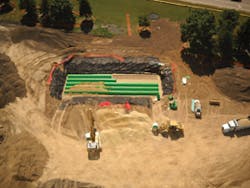Stormwater Management Projects Evaluate a Plethora of Site Considerations
Site-based stormwater management systems are defined by local regulatory requirements; the volume of stormwater collected and opportunities to optimize a site’s usable space. With site considerations and permit requirements in mind, stormwater management professionals select a system for the comprehensive solutions that the project ultimately will provide—these are among stormwater best management practices (stormwater BMPs). In Part One of a continuing series, Author Carol Brzozowski profiles various projects. These include (Triton) chamber installations, stormwater retention systems; underground storage (or filter and flush) solutions that meliorate volume reduction; maximize storage capacity; satisfy permit mandates and provide usable space whether for real estate or preserving existing infrastructure.
Stormwater Detention and Treatment – Carol Brzozowski
Protecting a local drinking water supply. Retaining and using stormwater onsite. Meeting regulatory requirements.
Treating stormwater in as small a footprint as possible. These reasons—and a combination of others—underscore a number of post-construction stormwater BMP projects in the United States.
Saving Space
Regulatory permits and real estate footprint are the two major considerations underscoring the choice of Triton S-29 chambers for a stormwater management project for a new parking lot to be constructed at the headquarters of a company in Maplewood, MN.
Darren C. Schwankl, P.E., LEED-AP, is with TKDA, an engineering architecture firm in St. Paul, MN. 3M Facilities Civil Engineering is a client of TKDA, and Schwankl says Triton had proven itself in a previous installation on the 3M campus.
“The number-one consideration was the local regulatory permit requirements mandated for rate control and volume reduction,” says Schwankl. “One of the reasons we chose Triton is that we had success using it in the past. This is our second installation here at 3M and our third installation overall for a company; we’ve done some work for another client here locally and had a double-stacked Triton system installed.”
Site-based stormwater management systems are defined by local regulatory requirements; the volume of stormwater collected and opportunities to optimize a site’s usable space. With site considerations and permit requirements in mind, stormwater management professionals select a system for the comprehensive solutions that the project ultimately will provide—these are among stormwater best management practices (stormwater BMPs). In Part One of a continuing series, Author Carol Brzozowski profiles various projects. These include (Triton) chamber installations, stormwater retention systems; underground storage (or filter and flush) solutions that meliorate volume reduction; maximize storage capacity; satisfy permit mandates and provide usable space whether for real estate or preserving existing infrastructure. Stormwater Detention and Treatment - Carol Brzozowski Protecting a local drinking water supply. Retaining and using stormwater onsite. Meeting regulatory requirements. Treating stormwater in as small a footprint as possible. These reasons—and a combination of others—underscore a number of post-construction stormwater BMP projects in the United States. [caption id="attachment_1858" align="alignleft" width="270"]The Triton S-29 chamber features 29-cubic-foot storage volume. Some 2,034 of the S-29 chambers are being used to cover a 32,450-square-foot area beneath the new parking lot, with the void space and the rock around it comprising 85,350 cubic feet.
Manufactured from a soy-based resin and from recycled materials, the Triton chambers are designed to be 46% lighter per cubic foot and up to 46% larger per linear foot, in contrast to other options.
“This underground system addresses both our rate control and our volume reduction pieces to the permit,” says Schwankl.
The biggest selling point for the underground system from 3M’s standpoint is the ability to maintain use of the real estate for something other than a traditional excavated stormwater pond, says Schwankl.
“In this case, we were able to meet permitted requirements, but also still maintain usable space for the parking lot and building, which is the driver of this project,” he adds.
Converting about 6.5 acres of what was once woods and meadows to a parking lot signaled the need to mitigate the flow rate, says Schwankl. Local requirements also called for groundwater recharge as part of the permit mandate.
“We look at volume reduction as an integral piece of the permit,” says Schwankl, adding that the Triton system works well in that regard and is able to filtrate a certain volume of runoff from the impervious surface.
In the first water retention project at 3M, the company was in need of a comprehensive stormwater solution to facilitate upgrades to a parking lot and building entrance to support a community walking path on its campus. Existing structures and landmarks could not be disturbed, and the path’s design required flexibility to fit with existing infrastructure. Space limitations called for an underground system that offered maximum storage capacity. Project managers had to protect municipal storm sewers. The project also had to be carried out with minimal disruption to the facility’s ongoing operations.
Triton SWS chambers were selected for the project because they were environmentally friendly and easy to install and maintain while offering the desired footprint and storage capacity.
Although that stormwater management project was on a smaller scale than the current one, it entailed similar requirements in working with local governmental units, says Schwankl.
“In that case, rate control was not a factor because we actually reduced the amount of impervious area with the project, but we still needed the Triton system to manage the volume reduction component of the permit,” he says.
“This new building addition, on the flip side of the campus, is a larger-scale project with a laboratory and office building complex being constructed on one of the last remaining pieces of green space on the campus. The system is much larger in scale than the first one.”
The chambers are onsite awaiting installation, which was to have taken place during spring 2014, but the abnormally harsh winter has pushed out the date.
“This is a long-range project,” says Schwankl, adding that it’s slated to take two years to complete and the site needs to be stabilized before construction begins.
The system will filter the first flush of runoff to the sand bed, Schwankl says. “We don’t have any empirical data on discharge, water clarity, suspended solids, or anything tangible to point to, but we’ve got an 18-inch-thick clean sand filtration bed that we run all of that initial first flush through and that’s our layer that gives us that water-quality piece as well as our infiltration piece.”
Pollutants of concern are another consideration. “That obviously includes heavy metals, oil, and the grit and sediment from wintertime when we use a lot of sand and salt up here. The salinity of the runoff as it is discharged to a wetland here immediately adjacent to the project site was considered,” says Schwankl.
“We do have an extensive vegetation system,” he says. “Not that it’s all considered pretreatment, but it’s certainly breaking up the concentration of the parking lot runoff, which is our primary concern.”
3M will be the responsible for maintenance as part of its overall campus maintenance procedures. Maintenance includes accessing the header rows for visual inspection and measuring the depth of sediment. Any accumulated sediment is jetted back to the front manholes, which are cleaned out with a vacuum truck.
If the first Triton installation is any indication, Schwankl expects a good outcome with the second one. “We’ve had good success with the one we’ve had in the ground,” he says. “It allows us to comply with the permit requirements yet still allows us to be able to use that real estate for something other than stormwater management.”



